Techniques and examples of using Pinterest to build a brand and connect with the student community
It’s no surprise - Pinterest drives an impressive amount of traffic. In fact, Pinterest is now 21% more popular than Twitter for US Internet users according to this Pew compilation of online US adults. This image discovery tool lets fans and influencers find and follow their favorite brands, whether it’s through products pinned from the website, or business pages created by brands.
Many brands, like Whole Foods, Etsy, and Kate Spade effectively use Pinterest to share information. The possibilities (and marketability) are truly endless.
Until recently, many universities did not have, or effectively use, Pinterest pages. The University of Michigan, often a risk-taker and thought leader among the Higher Ed social media community, saw an opportunity to utilize Pinterest in a unique way.
We wanted to connect with multiple audiences, both within Pinterest’s key demographic (80% women, 45% age 35-54), and our other audiences - high school and college students.
How did we connect via Pinterest?
For starters - while it’s important to note the demographics of Pinterest, this makes up some, but not all users. We had success connecting with our alumni in this key demographic, through boards like True Blue Weddings and Maize & Blue DIY, but we wanted to expand. Men, teenagers, college students, and the 50+ crowd still use Pinterest. If this is your audience, don’t ignore them!
Here are a few ways the University of Michigan is using Pinterest to connect with multiple audiences.

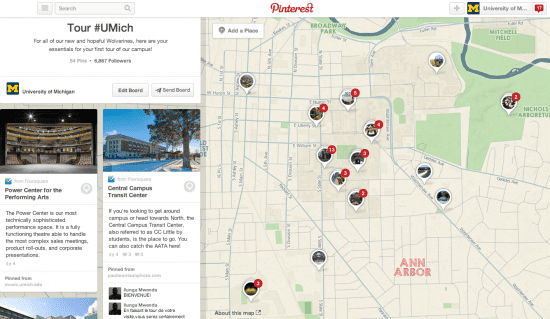
The Tour #UMich board, one of the two we created in our partnership with Pinterest for the launch of Place Pins, was created specifically with prospective students in mind.
Both our office of admissions and central accounts receive an incredible amount of questions from prospective students about the admissions process, student, and campus life. When Pinterest reached out to us about Place Pins, we immediately thought of solving this issue in a visual way. Now, international students can get a sense of our campus if they are unable to visit.
Students that may come to campus and cannot schedule an official tour (which fill up months in advance) can see all of the must-visit places, and pull up the maps on their phones to find them.
Here is an example of this solution in action. If we didn’t have this Place Board, this fan may have not opted to visit campus, as our tours are strictly for prospective students and parents, not necessarily fans just wanting to explore campus and see the highlights:
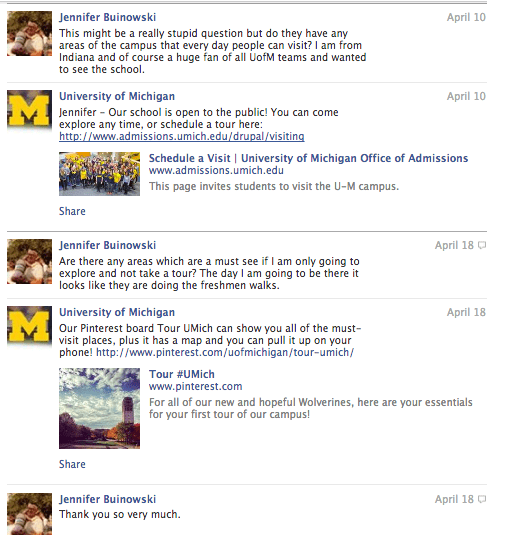
While every brand has their popular topics (for universities, it’s may be athletics, popular quotes and tag lines, and mascots), storytelling can highlight and attract attention to other moments of pride.
World-class donors, innovative research, and top-rated programs make the University of Michigan truly different from others. Creating a visual collection of 'The Michigan Difference' has attracted audiences from our world-class faculty and staff to professionals in the health and sciences communities.
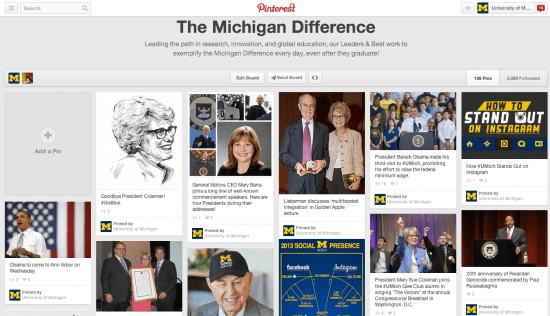
- 3. Show what makes You, 'You.'
Part of the University of Michigan’s legacy as a prestigious university is our history. Our university was founded in 1817, making us almost 200 years old. We are fortunate enough to have access to an extensive image bank from all parts of our history, and our followers LOVE to see these photos.
Historical photos are particularly popular among our alumni community, whether they’re trying to spot themselves in a photo, or recounting memories from their, or their parent’s time at the university.
Aside from being an excellent way to engage our fans, we’re heard a lot of great stories!
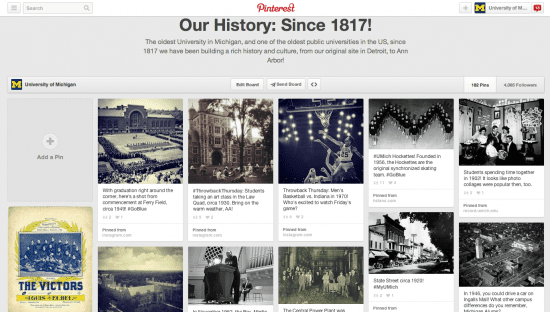
Our Student Resources board is one of the newest. Our university has an endless amount of resources, from the Sweetland Writing Center to the Career Center and the Alumni Association but why stop there? Allowing our students to see creative infographics and visual answers to tough questions they have throughout their time as a student (What do I do with my major? How do I find a job?) provides value to them, and ensures they will continue returning to our page.
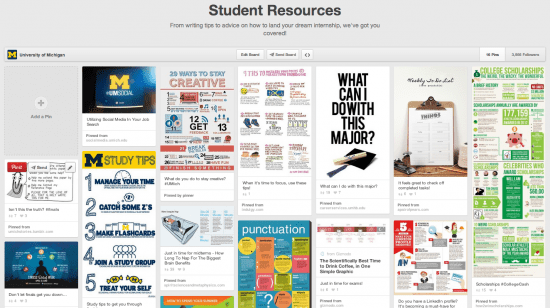 Additionally, student-specific blogs help us reach the younger demographics.
Additionally, student-specific blogs help us reach the younger demographics.
- 5. Assess the Competition
A great way to benchmark your success is to track your competitors on Pinterest. There are a few options for Pinterest analytics, or you can record your and your competitor’s followers and Pins the old fashioned (and free!) way - with an Excel spreadsheet.

We track our progress, and our competitors weekly, but for smaller brands with a slower-growing following, you may only need to track bi-weekly or monthly to get a sense of the growth.
Aside from showing where you stack up against your competitors, seeing these rankings week over week is addicting!
Overall, Pinterest has been a huge asset to the University of Michigan’s social presence. In the fall, we’re hoping to bring our Pinterest audience offline with on-campus events, and continue to connect with our incoming and current students. Stay up to date with our latest social stories on our website, and feel free to give us a follow on Pinterest.
Thanks to Hillary Frazier for sharing her thoughts and opinions on this blog post. Hillary Frazier is a social media specialist at the University of Michigan. She is responsible for creating content, executing campaigns and sharing her experiences and expertise at the university, and online. You can connect with her on
LinkedIn or Twitter
@HillaryxFrazier or
@umich.












